Category Archives: Research & projects
Engineering in Society – new module for engineering citizenship
Undergraduate student engineers at UWE Bristol will get the chance to learn about engineering citizenship from September.
The Science Communication Unit is launching a new module to highlight the importance of professional development, lifelong learning, and the competencies and social responsibilities required to be a professional engineer.
It follows a successful public engagement project led by Laura Fogg-Rogers in in 2014, called Children as Engineers. The new module is being funded by HEFCE to advance innovation in higher education curricula.
The 65 students, who are in the third year of their BEng or MEng degrees, will learn about the engineering recruitment shortfall and the need to widen the appeal of the profession to girls and boys. They will then develop their communication and public engagement skills in order to become STEM Ambassadors for the future.
The module is unique in that it pairs the student engineers with pre-service teachers taking BEd degrees on to be peer mentors to each other. The paired students will work together to deliver an engineering outreach activity in primary schools, as well as respectively mentoring each other in communication skills and STEM knowledge.
The children involved in the project will present their engineering designs back to the student engineers at a conference at UWE in 2018. Previous research shows that it positively changes children’s views about what engineering is and who can be an engineer .
Teacher Asima Qureshi of Meadowbrook Primary school in Bradley Stoke says;
“The Children as Engineers Project was a very successful project in our school. The highlight was the opportunity to showcase their designs at the university and be able to explain the science behind it. It has hopefully inspired children to become future engineers.”
The pilot project was also successful at improving teachers’ STEM subject knowledge confidence and self-efficacy to teach it. This is vitally important, as only 5% of primary school teachers have a higher qualification in STEM, and yet attitudes to science and engineering are formed before age 11.
 Professional engineers in the Bristol region are invited to learn from the project and mentor the students as part of the new Curiosity Connections Bristol network . Delegates are welcome to attend the inaugural conference on November 23rd 2017 to share learning with other STEM Ambassadors and professional teachers in the region.
Professional engineers in the Bristol region are invited to learn from the project and mentor the students as part of the new Curiosity Connections Bristol network . Delegates are welcome to attend the inaugural conference on November 23rd 2017 to share learning with other STEM Ambassadors and professional teachers in the region.
Laura Fogg-Rogers, University of the West of England (UWE) Bristol UK
SynBio – in need of public engagement
In a recent book review for JCOM, I outlined a few of the ethical, social and legal issues that make synthetic biology a potentially fascinating topic from a public engagement perspective. ‘Synthetic Biology Analysed’ (Englehard, 2016) draws together contributions from experts in ethics, law, risk analysis and sociology. In doing so, it provides a fairly accessible discussion of the nature of synthetic biology – what the field encompasses and how we might think about different types of synthetic biology (from those that are essentially developments of genetic engineering to approaches that incorporate non-naturally occurring nucleotides (components of DNA)). These raise different challenges when it comes to assessing risk, for example to the environment, posed by these developments.
Shortly after reading Englehard’s (2016) book, I had the opportunity to explore synthetic biology further, through a participatory theatre project – Invincible – initiated by the University of Bristol’s SynBio group and produced by Kilter theatre company. Both Englehard’s book and ‘Invincible’ the theatre production point to a need for public engagement in this area.
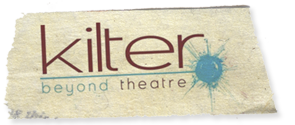
Speaking to the members of the Invincible production team, I learned much about the process of developing this work and the learning curve that had to be climbed in order to understand the research. Kilter were also keen to address other STEM issues, such as presenting women as scientists to counter gender stereotypes.
One aspect of the performance I found particularly refreshing was the way that actual researchers were included. They may not have had ‘acting’ roles, but they were present throughout and engaged in discussion with the audience at the end of the performance (when their presence was revealed). Their inclusion, and the setting of the performances in a flat both worked to highlight the pervasiveness of science in our lives.
In a chapter focusing specifically on public engagement in Synthetic Biology Analysed, Pardo and Hagen point out the low salience of synthetic biology with the public. While this is not uncommon, with many scientific topics taking place silently and behind closed doors, the potential impacts (social and environmental) of synthetic biology highlighted in Englehard’s book suggest it is time for a public discussion. It is nice to see that University of Bristol’s SynBio group are beginning to hold this conversation.
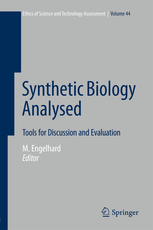
ENGELHARD, M. ED. (2016). SYNTHETIC BIOLOGY ANALYSED: TOOLS FOR DISCUSSION AND EVALUATION. SPRINGER INTERNATIONAL.
Emma Weitkamp
Communicating science across Europe
 Since May 2016, the Science Communication Unit has been involved with a four year, Europe-wide research project ClairCity. Laura Fogg Rogers, Margarida Sardo and Corra Boushel are all staff members on the project, leading the communication, dissemination and evaluation. Working on large-scale international projects requires a slightly different set of sci-comm skills to local or national projects. ClairCity is specifically about air pollution in cities, so communication is also affected by the fact that the team are working on issues that affect the public and their health every day.
Since May 2016, the Science Communication Unit has been involved with a four year, Europe-wide research project ClairCity. Laura Fogg Rogers, Margarida Sardo and Corra Boushel are all staff members on the project, leading the communication, dissemination and evaluation. Working on large-scale international projects requires a slightly different set of sci-comm skills to local or national projects. ClairCity is specifically about air pollution in cities, so communication is also affected by the fact that the team are working on issues that affect the public and their health every day.

ClairCity is an innovative air quality project involving citizens and local authorities in six countries around Europe. There are sixteen partner organisations involved in the project, which is funded by the EU Horizon 2020 fund. The project activities are geographically focused in six areas – two regions and four cities. These are: Amsterdam in the Netherlands; Bristol in the UK; Ljubljana in Slovenia; Sosnowiec in Poland; the Aveiro region in Portugal and the Liguria region around Genoa in Italy. The project aims to model citizens’ behaviour and activities to enrich public engagement with city, national and EU policy making about air quality and health. The resulting policy scenarios will allow cities to work towards improved air quality, reduced carbon emissions, improved public health outcomes and greater citizen awareness.

Each city or region is hosting a series of events and special activities to engage citizens in the ClairCity process and with the issues of air pollution and public health. The range of activities is designed to attract a range of different audiences into the project. There are large, online surveys, face-to-face encounters, workshops for citizens and local organisations, an online game, a free app, a schools’ competition, film-making with older people, city events and celebrations of cleaner air and better health. Promoting each of these requires planning for different audiences, meaning different media of communication, messaging, timescales and targets.
Our public activities in Bristol will start in May 2017, with our Bristol game release scheduled for April 2018.
Top tips for large, international projects:
- Get to know your partners. They are the gatekeepers to your local audiences and they will know the issues, processes and politics.
- Translation is an art, not a science. Google translate can do marvels to understand incoming emails or tweets, but of course if you are communicating with a public outside of the writer’s native language, find a translator that you trust. This might even need to be a science writer.
- Art can be international. Strong graphics can help to give your project a shared identity across multiple languages, in a way that infographics, diagrams and text will struggle. ClairCity had a graphic notetaker at the first project meeting and the output has been invaluable to giving an identity to the project.
- Don’t forget time differences when organising skype calls!
Dr. Corra Boushel
Shall we talk about robots and public engagement? Ten years on.
2017 marks the ten-year anniversary since I started working on the Talking Robots project with my former SCU colleagues Karen Bultitude and Emily Dawson. A lot has been happening in robotics since then (you can read a quick summary of some key developments from the last ten years in Robotics Trends) but at the time we were interested in two key questions; What were people’s attitudes towards robotic technologies, and how were publics being engaged around these developments?
Ten years on it’s interesting to consider how many findings from this project are still relevant to public engagement. In one journal article based on this project we took the chance to explore the perspectives of the engagers and researchers involved in a series of different types of public engagement events regarding robotics in a bit more detail. The article ‘Oh yes, robots! People like Robots; the Robot people should do something’, is full of information on some of the benefits and constraints engagers identified in their work. Expectations, organisational aspects and practical issues could have a considerable impact on engagement events, but there were also signs that, a decade ago, engagers were feeling more supported and prepared to engage, and conscious of a desire amongst people to ask questions, not only to learn. We also found that definitions of public engagement, which some have more recently described as a ‘buzzword’, were by no means fixed:
‘Scientists do not operate with one definition of public engagement (Davies, 2008), instead moving between flexible, diverse and disjointed notions suggesting that ‘engagers’, ‘organisers’ and ‘audiences’ alike will change their engagement agendas if and when controversies arise.’ (Wilkinson, Bultitude and Dawson, 2010).
Alongside those seeking to engage, we were also interested in finding out a bit more about the people who participate in public engagement activities focused on robotics. In our article ‘Younger people have like more of an imagination, no offence’ we wanted to know more about why people, publics, you and me, were engaging, where they came from and what they wanted to achieve. This is something researchers are still interested in today. The recent National Academies of Sciences, Engineering and Medicine report ‘Communicating Science Effectively’ highlights that people’s ‘needs and opinions’ can change and thus, over time, effective communication must also be ‘iterative and adaptable’, perhaps no more so than in 2017.
Looking back to 2007 we found that there were lots of reasons why people were attending their local science centre, visiting a science café or participating in a school workshop. Some were attracted by the subject matter, others because it was part of their usual routines. And whilst they often empathised with the researchers they interacted with, they also had clear expectations of them and individual hopes as to what they would gain from an experience. But there were challenges:
‘Participants often struggled to identify how members of the public might participate and contribute their view in engagement settings, though often there was an underlying perception that engagement was considered ‘citizenly’. They identified that certain subjects had a greater relevance to public participation than others, in particular those with societal relevance… The challenge for those engaging publics is thus to effectively communicate the aims of such activities and appreciate the differing notions of role and participation that may exist amongst their participants.’ (Wilkinson, Dawson and Bultitude, 2012).
Some, more recent studies, continue to explore these themes, such as Gehrke’s (2014) interest in ‘existing publics’, and of course, there is now the added edge of the role of public engagement in ‘post truth politics’.
So ten years on are these issues still relevant? In my view, it’s a yes, and yes. We can still learn more about how researchers consider, engage and communicate around their work, particularly as research agendas shift and change, and the culture of engagement matures. And there’s always more to understand about people, how and why they participate, as well as why they don’t. As for robotics itself, there will also of course, be ever emerging developments, some of which will pose philosophical, ethical and social questions in the future. Are we still interested in ‘Talking Robots’, I think so.
Clare Wilkinson
Both Talking Robot articles are openly available via the UWE Research Repository:
http://eprints.uwe.ac.uk/15336/8/Manuscript%20-%20Oh%20Yes%20the%20Robots.pdf
Talking Robots was funded by the ESRC (RES-000-22-2180).
New and notable – further selected publications from the Science Communication Unit
Last week we posted details of our work on environmental policy publications as well as our research on outreach and informal learning. This week’s blog highlights our work in public engagement with robotics and robot ethics, as well as our work on science communication in wider cultural areas, including film, theatre and festivals. We also revisit the controversial issue of ‘fun’ in science communication.
Robot Ethics
Winfield, A. F. (2016) Written evidence submitted to the UK Parliamentary Select Committee on Science and Technology Inquiry on Robotics and Artificial Intelligence. Discussion Paper. Science and Technology Committee (Commons), Website. Available from: http://eprints.uwe.ac.uk/29428
This is a slightly unusual publication; here Professor Alan Winfield tells the story behind it. In March 2016 the UK Parliamentary Select Committee on Science and Technology opened an inquiry on Robotics and Autonomous Systems they posed four questions; the fourth of which held the greatest interest for me: The social, legal and ethical issues raised by developments in robotics and artificial intelligence technologies, and how they should be addressed? Then, in April, I was contacted by the EPSRC RAS UK network and asked if I could draft a response to this question to then form part of their response to the inquiry. This I did, but of course because of the word limit on overall responses, my contribution to the RAS UK submission was, inevitably, very abbreviated. I was also asked by Phil Nelson, CEO of EPSRC, to brief him prior to his oral evidence to the inquiry, which I was happy to do. Following the first oral evidence session I then wrote to the Nicola Blackwood MP, (then) chair of the Select Committee. In response the committee asked if they could publish my full evidence, which of course I was very happy for them to do. My full evidence was published on the committee web pages on 7 June. To compete the story the inquiry published its full report on 13 September 2016, and I was very pleased to find myself quoted in that report. I was equally pleased to see one of my recommendations – that a commission be set up – appear in the recommendations of the final report; of course other evidence made the same recommendation, but I hope my evidence helped!
Our public engagement projects also influence research as this paper by the Eurathlon consortium shows. The paper reports on the advancement of the field of robotics achieved through the Eurathlon competition:
Winfield, A. F., Franco, M. P., Brueggemann, B., Castro, A., Limon, M. C., Ferri, G., Ferreira, F., Liu, X., Petillot, Y., Roning, J., Schneider, F., Stengler, E., Sosa, D. and Viguria, A. (2016) euRathlon 2015: A multi-domain multi-robot grand challenge for search and rescue robots. In: Alboul, L., Damian, D. and Aitken, J. M., eds. (2016) Towards Autonomous Robotic Systems. (9716) Springer, pp. 351-363. Available from: http://eprints.uwe.ac.uk/29283
“Fun” in science communication
The following two publications are the same text published in two different books (with permission). The chapters summarise the views of the authors, including our own Dr Erik Stengler, about the use of fun in science communication, and specifically in science centres.
Viladot, P., Stengler, E. and Fernández, G. (2016) From fun science to seductive science. In: Kiraly, A. and Tel, T., eds. (2016) Teaching Physics Innovatively 2015. ELTE University. ISBN 9789632848150 Available from: http://eprints.uwe.ac.uk/27793
Viladot, P., Stengler, E. and Fernández, G. (2016) From “fun science” to seductive science. In: Franche, C., ed. (2016) Spokes Panorama 2015. ECSITE, pp. 53-65. Available from: http://eprints.uwe.ac.uk/29105
Both of these are related to a rather controversial blogpost hosted on the SCU blog. That post was selected for publication in a book that captures a collection of thought-provoking blog posts from the Museum field all over the world. In it Erik expressed in a more informal and provocative manner the ideas in the above papers.
Stengler, E. (2016) Science communicators need to get it: Science isn’t fun. In: Farnell, G., ed. (2016) The Museums Blog Book. MuseumsEtc. [In Press] Available from: http://eprints.uwe.ac.uk/30360
Science communication through wider cultural activities
A recent commentary explores the factors that contribute to festival goers’ choice to attend science-based events at a summer cultural festival. Presented with a huge variety of interesting cultural events, attendances at science-based events were strong, with high levels of enjoyment and engagement with scientists and other speakers. Our research found out that audiences saw science not as something distinct from “cultural” events but as just another option: Science was culture.
Sardo, A.M. and Grand, A., 2016. “Science in culture: audiences’ perspective on engaging with science at a summer festival”. Science Communication Vol. 38(2) 251–260.
This is a paper on science communication through online videos, long awaited by the small community of researchers working on this specific field who met at the conference above. It reports research conducted by interviewing the people behind the most viewed and relevant UK-based science channels in YouTube. One clear conclusion is that whilst all are aware of the great potential of online video with respect to TV broadcasting, only a few, mainly the BBC, has the insight and the means to realise it in full:
Erviti, M. d. C. and Stengler, E. (2016) Online science videos: An exploratory study with major professional content providers in the United Kingdom. Journal of Science Communication. [In Press] Available from: http://eprints.uwe.ac.uk/30236
One area we are interested in is the impact of cultural events on the audience. In this recent paper, we explore the impact of a performance about haematological stem cell transplant on two key audiences: haematology nursing staff and transplant patients. The article suggests that this type of performance is beneficial to both groups, encouraging nursing staff to think differently about their patients and allowing patients to reflect on their past experience in new ways.
Weitkamp, E and Mermikides, A. (2016). Medical Performance and the ‘Inaccessible’ experience of illness: an Exploratory Study, Medical Humanities, 42:186- 193. http://mh.bmj.com/content/42/3/186 (open access)
We’re also very pleased to highlight a publication arising from a student final year project. This was first presented at an international conference in Budapest. It presents the results of a study of the Physics and Astronomy content of At-Bristol in relation to the national curriculum:
Stengler, E. and Tee, J. (2016) Inspiring pupils to study Physics and Astronomy at the science centre at-Bristol, UK. In: Kiraly, A. and Tel, T., eds. (2016) Teaching Physics Innovatively 2015. ELTE University. ISBN 9789632848150 Available from: http://eprints.uwe.ac.uk/28122
As we are keen to share our learning more widely, we also occasionally report from conferences. This report, published in JCOM, summarizes highlights of the sessions Erik attended at the 15th Annual STS conference in Graz. It focuses on sessions relevant to robotics and on science communication through online videos, the latter being the session where Erik presented a paper (see next item below):
Stengler, E. (2016) 15th annual STS Conference Graz 2016. Journal of Science Communication. ISSN 1824-2049 Available from: http://eprints.uwe.ac.uk/29106
We hope that you find our work interesting and insightful – details of all our publications to date can be found on the Science Communication Unit webpages.
New and notable – selected publications from the Science Communication Unit
The last 6 months have been a busy time for the Unit, we are now fully in the swing of the 2016/17 teaching programme for our MSc Science Communication and PgCert Practical Science Communication students, we’ve been working on a number of exciting research projects and if that wasn’t enough to keep us busy, we’ve also produced a number of exciting publications.
We wanted to share some of these recent publications to provide an insight into the work that we are involved in as the Science Communication Unit.
Science for Environment Policy

Science for Environment Policy is a free news and information service published by Directorate-General Environment, European Commission. It is designed to help the busy policymaker keep up-to-date with the latest environmental research findings needed to design, implement and regulate effective policies. In addition to a weekly news alert we publish a number of longer reports on specific topics of interest to the environmental policy sector.
Recent reports focus on:
Ship recycling: The ship-recycling industry — which dismantles old and decommissioned ships, enabling the re-use of valuable materials — is a major supplier of steel and an important part of the economy in many countries, such as Bangladesh, India, Pakistan and Turkey. However, mounting evidence of negative impacts undermines the industry’s contribution to sustainable development. This Thematic Issue presents a selection of recent research on the environmental and human impacts of shipbreaking.
Environmental compliance assurance and combatting environmental crime: How does the law protect the environment? The responsibility for the legal protection of the environment rests largely with public authorities such as the police, local authorities or specialised regulatory agencies. However, more recently, attention has been focused on the enforcement of environmental law — how it should most effectively be implemented, how best to ensure compliance, and how best to deal with breaches of environmental law where they occur. This Thematic Issue presents recent research into the value of emerging networks of enforcement bodies, the need to exploit new technologies and strategies, the use of appropriate sanctions and the added value of a compliance assurance conceptual framework.
Synthetic biology and biodiversity: Synthetic biology is an emerging field and industry, with a growing number of applications in the pharmaceutical, chemical, agricultural and energy sectors. While it may propose solutions to some of the greatest challenges facing the environment, such as climate change and scarcity of clean water, the introduction of novel, synthetic organisms may also pose a high risk for natural ecosystems. This future brief outlines the benefits, risks and techniques of these new technologies, and examines some of the ethical and safety issues.
Socioeconomic status and noise and air pollution: Lower socioeconomic status is generally associated with poorer health, and both air and noise pollution contribute to a wide range of other factors influencing human health. But do these health inequalities arise because of increased exposure to pollution, increased sensitivity to exposure, increased vulnerabilities, or some combination? This In-depth Report presents evidence on whether people in deprived areas are more affected by air and noise pollution — and suffer greater consequences — than wealthier populations.
Educational outreach
We’ve published several research papers exploring the role and impact of science outreach. Education outreach usually aims to work with children to influence their attitudes or knowledge about STEM – but there are only so many scientists and engineers to go around. So what if instead we influenced the influencers? In this publication, Laura Fogg-Rogers describes her ‘Children as Engineers’ project, which paired student engineers with pre-service (student) teachers.
Fogg-Rogers, L. A., Edmonds, J. and Lewis, F. (2016) Paired peer learning through engineering education outreach. European Journal of Engineering Education. ISSN 0304-3797 Available from: http://eprints.uwe.ac.uk/29111
Teachers have been shown in numerous research studies to be critical for shaping children’s attitudes to STEM subjects, and yet only 5% of primary school teachers have a STEM higher qualification. So improving teacher’s science teaching self-efficacy, or the perception of their ability to do this job, is therefore critical if we want to influence young minds in science.
The student engineers and teachers worked together to perform outreach projects in primary schools and the project proved very successful. The engineers improved their public engagement skills, and the teachers showed significant improvements to their science teaching self-efficacy and subject knowledge confidence. The project has now been extended with a £50,000 funding grant from HEFCE and will be run again in 2017.
And finally, Dr Emma Weitkamp considers how university outreach activities can be designed to encourage young people to think about the relationships between science and society. In this example, Emma worked with Professor Dawn Arnold to devise an outreach project on plant genetics and consider how this type of project could meet the needs of both teachers, researchers and science communicators all seeking (slightly) different aims.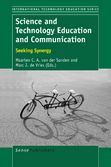
A Cross Disciplinary Embodiment: Exploring the Impacts of Embedding Science Communication Principles in a Collaborative Learning Space. Emma Weitkamp and Dawn Arnold in Science and Technology Education and Communication, Seeking Synergy. Maarten C. A. van der Sanden, Delft University of Technology, The Netherlands and Marc J. de Vries (Eds.) Delft University of Technology, The Netherlands.
We hope that you find our work interesting and insightful, keep an eye on this blog – next week we will highlight our publications around robots, robot ethics, ‘fun’ in science communication and theatre.
Details of all our publications to date can be found on the Science Communication Unit webpages.
Innovating university outreach
Corra Boushel
Through funding from the Higher Education Funding Council for England and internal backing, the Science Communication Unit has been involved in developing an ambitious new UWE Bristol outreach programme for secondary schools in the region. We’ve worked with over 4,000 school pupils in the last 18 months, finding tardigrades, hacking robots and solving murder mysteries with science, technology, engineering and maths.
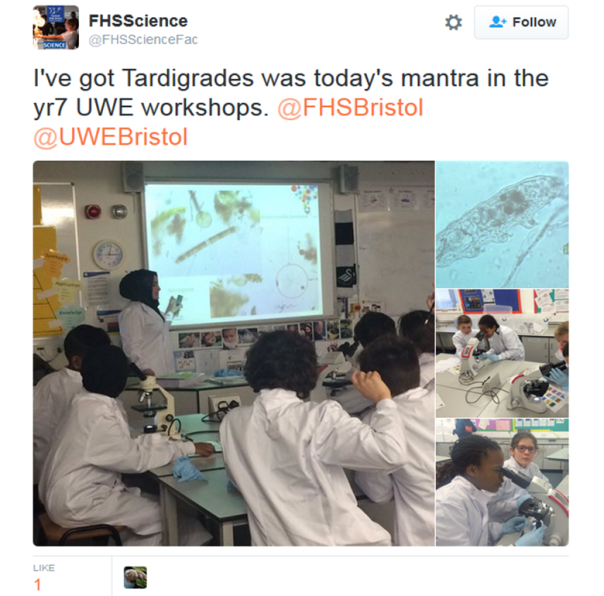
The idea behind the project is not only to engage local communities and raise pupil aspirations. Our plan is to refocus outreach within the university so that it no longer competes with student learning or research time, but instead functions to develop undergraduate skills and to showcase UWE Bristol’s cutting edge research.

The outreach activities are developed by specialists, but then led by undergraduate students and student interns, who develop confidence and skills. UWE Bristol students can use their outreach activities to count towards their UWE Futures Award, and in some degree courses we are looking at ways that outreach projects can provide credit and supplement degree modules. Researchers can use the activities to increase their research impact and share their work with internal and external audiences – getting students excited about research through explaining it to young people. Enabling students to lead outreach – including Science Communication Masters and Postgraduate Certificate students – means that the university delivers more activities, reaching more schools and giving more school pupils the chance to participate.

The brainchild of UWE Bristol staff Mandy Bancroft and John Lanham, the development stages of the project have been led by Debbie Lewis and Corra Boushel from the Faculty for Health and Applied Science and the Science Communication Unit with support from Laura Fogg Rogers. The project is now being expanded into a university-wide strategy with cross-faculty support to cover all subject areas, not only STEM.
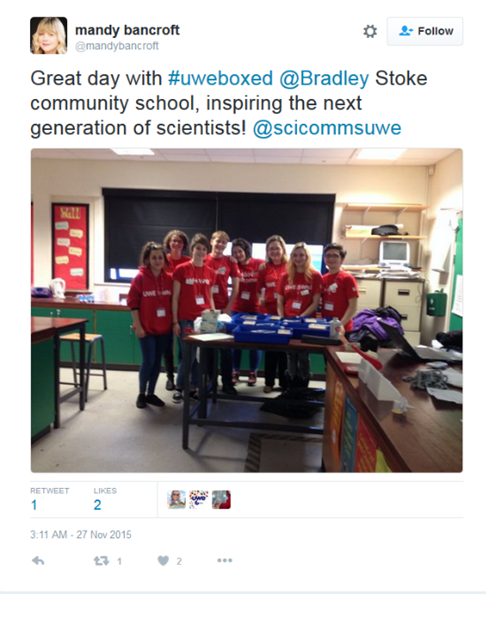 Special thanks on the project go to all of our student ambassadors and previous interns, as well as our current team of Katherine Bourne, Jack Bevan and Tay-Yibah Aziz. Katherine and Tay-Yibah are employed on the project alongside their studies in the Science Communication Unit.
Special thanks on the project go to all of our student ambassadors and previous interns, as well as our current team of Katherine Bourne, Jack Bevan and Tay-Yibah Aziz. Katherine and Tay-Yibah are employed on the project alongside their studies in the Science Communication Unit.
What IS storytelling? What IS NOT storytelling?

What IS storytelling? What IS NOT storytelling? These two questions opened the 9th conference on “Storytelling: Global Reflections on Narrative” I attended from the 10th to the 12th of July in Oxford (UK). As participants, we were asked to reply, and we gave completely different answers, depending on our academic field and personal experience.
We defined storytelling as an engaging and dynamic form of communication, which must not be boring at all. Moreover, we emphasised the fact that storytelling does not include only what is told, but also what is kept silent, what is not remembered, and what is changed, and that it encompasses many points of view, many different stories, and many different ways of telling the same story.
During the conference, each speaker contextualised storytelling in a different field: literature, history, sociology, communication, education, sciences, and even medicine; and we discussed the topic taking into account professional and personal experiences as well, thus getting a broad and inclusive overview of storytelling.
Storytelling is not only influenced by the discipline in which it’s studied or applied, but also by many other factors, such as background, culture, education, ethnicity, nationality, social class, gender, and age of storytellers and of the audiences.
Novels, advertisements, TV shows, etc. communicate a story using language, semiotic signs, stereotypes, metaphors, and rhetoric figures that are tailored for specific target publics. Moreover, stories usually reflect the social values and characteristics of the audiences. For example, in Japanese anime the homogeneity of the Japanese society is represented by the possibility each character has to become the protagonist of the story, whereas individualistic feature of the Western societies is depicted by the presence of only one main character in Western comics.
Medium may change the way we tell or listen to a story. We read novels in a sequential way, page after page from the beginning to the end, whereas we can read a story on social media in a relational way (as in mind mapping), jumping from one point to any other as we please. Moreover, in digital interactive documentaries and videogames, we (as audience) can even change the story.
Storytelling also differs in its applications: we can use it for conveying information or entertaining, but we can also use it for advocacy campaigns, education, and research. Indeed, storytelling can be a suitable technique for advocacy, due to its capability of engaging audiences emotionally and personally, and it is effective in involving students in school lessons as well, and in stimulating their critical thinking, communication and writing skills, creativity etc.
The use of storytelling in the research field is particularly interesting. By analysing either ancient books or new TV fictions, we can investigate the individual characteristics of authors as well as well the social beliefs, values, and imaginary of a specific historical period, and we can study how they changed over time. We can acquire similar data by collecting witnesses’ stories of a specific event, as well as asking the research subjects to write a narrative on a specific issue. For example, patients’ stories on how they perceive their disease and how it is affecting their quality of life can provide further information to improve our comprehension of the disease from a clinical point of view, understand patient-physician communication, or improve the health care system. Even collecting stories on digital media and videogames we can yield insights on individuals and social groups’ characteristics.
What is storytelling? What is not storytelling? Though it may be very difficult to give a concise and inclusive answer to these questions, we can say that storytelling provides many different opportunities and challenges in science and health communication as well as in research.
Find out more about the conference ‘Storytelling: Global Reflections on Narrative‘
Elena Milani – PhD student, Science Communication Unit.

Baby-led, puree, Annabel Karmel and me? When science impacts on the choices we make in parenting
How we make choices as consumers, patients, parents and members of the public has, of course, long been of interest to science communicators, and topics like immunisation can continue to raise differences in perspectives, as well as media interest. A few years ago we started to think about the sometimes challenging process of weaning a baby. Ruth had recently had two young children herself, whilst completing her MSc Science Communication with us, and I’d been doing some research with parents and caregivers in community groups, so we knew weaning was a topic that was being discussed. But what about the parents who might not be out there in these social spaces, what was happening online? We asked the question ‘how do people on Mumsnet frame media coverage of weaning?’
As our starting point we considered a review of scientific evidence published in the British Medical Journal in 2011. This work, by Fewtrell and colleagues, suggested the period of exclusive breastfeeding recommended by the World Health Organisation be reduced from six months to four. Unsurprisingly the study attracted media attention, particularly in ‘quality’ newspapers like The Times, The Guardian, and especially, The Telegraph, and was frequently reported on by specialist health and science correspondents. They tended to talk about ‘risk’ but rarely contextualised that with further information on the study itself.
On Mumsnet it was clear that a vibrant community was keen to discuss the issue of weaning, and we located 112 comments that directly referred to the Fewtrell example and its media coverage. What were people most wanting to talk about? The inaccuracy of media coverage really stood out in their comments, as well as frustration that it was returning to the breast vs. bottle aspects of the debate. And the forum discussions often presented more context, nuances around the question of ‘risk’ and the details of the study itself. Of course, they had more room to do so, but it was interesting to see these types of details being discussed.
What does this tell us about science, the media and how it’s discussed online? Well it suggests that at least amongst this very small sample of Mumsnet users there is some awareness of the weaknesses that can be present in science and health reporting, but also that people often use scientific and personal information in transitionary means, embellishing some of the deficiencies of media coverage in interesting and new ways. As people become more and more reliant on social media sources for information, further work is needed on how this is supplementing and challenging our relationships with scientific and medical expertise but also how we use our social networks to support decision making. You can find out more about this work in a recent Journalism article or at:
http://eprints.uwe.ac.uk/27843/3/The_Worries_of_Weaning_paper_10_10_15%20-%20Copy.pdf
Clare Wilkinson and Ruth Knowles





